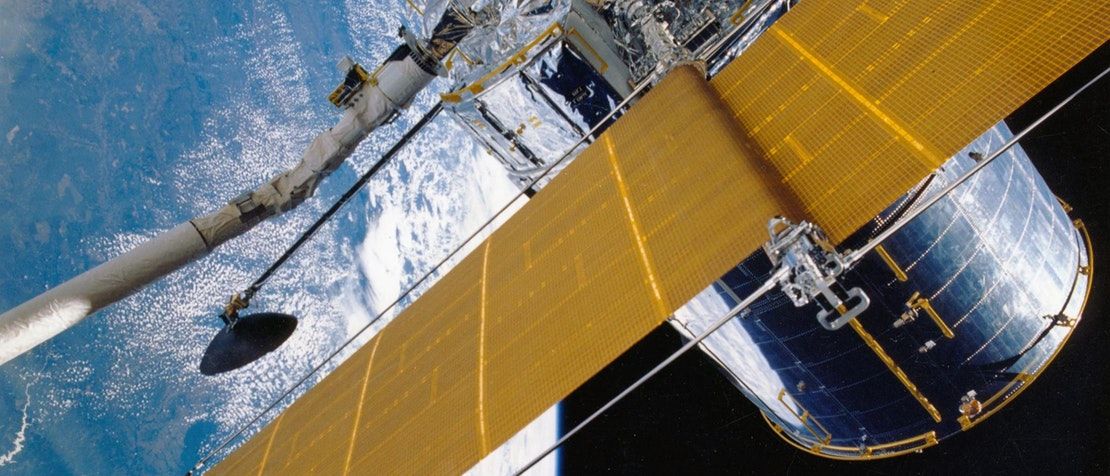
Reducing harmful interference to satellites near Earth, the Moon and beyond
A month ago, you were watching a football match using your new satellite dish when suddenly the image went fuzzy – only to return after a game-winning goal that you had just missed.
Last week, while paying for groceries your card transaction didn’t go through – even though you had just received your monthly salary.
And today, while working from home your internet connection was abruptly cut – with social media services down and no mobile service reception, there was simply no way to deliver that project on deadline!
These common frustrations we have all experienced on the ground could very well be chalked up to the increasing demands being placed on satellite systems orbiting high above our heads.
Not only can the obstruction of these systems affect our daily lives, but it can also prevent the collection of accurate scientific measurements, distort navigation by air and sea, and interrupt many other space services, from satellite broadcasting to deep space research.
During the first in a series of three ITU Satellite webinars, over 600 participants from around the world examined how harmful interference impacts the space ecosystem, focusing on how ITU and stakeholders can prevent and reduce interference so that space services can operate unimpeded.
“Space services play a key role in achieving the SDGs,” said ITU Radiocommunication Bureau Director Mario Maniewicz in his opening remarks. “But these services need to be protected from harmful interference to do so.”
What is harmful interference?
One of the main mandates of ITU, according to its Constitution and through its Radiocommunication Sector (ITU-R), is to enable radiocommunication services to operate without receiving or causing harmful radio-frequency interference (RFI).
According to the ITU Radio Regulations, interference is defined as harmful if it endangers the functioning of a radio navigation or of other safety services, or if it degrades, obstructs, or interrupts a radiocommunication service that is operating in accordance with the Radio Regulations.
While the majority of cases are dealt with directly between satellite operators, sometimes they need to be escalated to government administrations. If these bilateral efforts cannot resolve the harmful interference, the concerned administration can then request assistance from ITU’s Radiocommunication Bureau (BR).
How harmful interference affects different ecosystems
When it comes to satellites in the Earth’s orbit, such as those that perform passive remote sensing (PRS) for Earth observations, interference can lead to inaccurate weather data and climate models.
“PRS requires very sensitive, low-noise receivers,” said Elena Daganzo-Eusebio of the European Space Agency. “Emissions above a certain level may constitute harmful interference – [PRS systems] can’t differentiate wanted signal from interference sometimes.”
Even if just a little bit of interference creeps into a PRS system, scientists could take measurements that seem plausible, eventually feeding that data into climate change models.
“NASA doesn’t do weather forecasting, but we do send our data to weather forecasters,” said Glenn Feldhake of NASA. “This is bad data that goes into weather models. What happens when we want to figure out where hurricanes are going? When they will make landfall? Who do we evacuate? Where do we send supplies?”
In some cases, instances of harmful interference have targeted radio navigation-satellite service (RNSS) signals used by civil aviation, threatening international air traffic with worrying consequences including potential loss of life.
Vulnerabilities and interruptions of the Global Navigation Satellite System are becoming more common, according to Gerhard Berz of Eurocontrol.
“In the last 2 years, we received an average of 10 GPS reports daily from the cockpit of aircraft. This is having a known operational impact,” Berz added.
Sometimes interference is intentional, said Ethan Lavan, representing Eutelsat. While it occurs relatively infrequently, this kind of interference is most difficult to solve, and has the direst consequences, he said. While harmful interference mainly affects satellites orbiting Earth, it can also disturb the lunar space environment in the future.
While it is now quiet, “the Moon is about to get busy,” advised Feldhake.
“From point-to-point links on the lunar surface to mobile links, to links from the Moon to Earth, to things orbiting the Moon, to different operators … [interference] becomes a very complex issue to get a grip on quickly,” he added.
“We need to coordinate our lunar activities,” affirmed Feldhake. “If we are not all working together, it could be a mess up there!”
While many space agencies are cooperating, they are simultaneously trying to cooperate with commercial entities that also want to explore commercial activities on the Moon, such as mining or even tourism, he said.
Reporting: key to prevent harmful interference
Berz said that new operational principles are being implemented to mitigate harmful interference in communication, navigation and surveillance systems in aviation. According to Lavan, geolocalization through a transmitter location system (TLS) can help identify the origin of the interfering signal.
When no resolution is forthcoming, it is crucial to “engage in the ITU process which relies on goodwill and good intentions to respect the [Radio Regulations] treaty,” he said. All panelists agreed that ITU, Member States and other space stakeholders each have a critical role when it comes to reporting incidences of harmful interference.
“We need more information from you to measure the actual situation,” affirmed moderator and ITU Senior Radiocommunication Engineer Jorge Ciccorossi to participants, encouraging them to use ITU’s Satellite Interference Reporting and Resolution System (SIRRS).
Released in 2018, SIRRS enables space stakeholders to report harmful interference affecting space services as well as to receive support from ITU. Through the system, ITU is accumulating an international repository of interference incidences, making them easier to track, analyze and resolve.
“Since SIRRS [was implemented], we have noticed an improvement in the response of the administrations,” noted Daganzo-Eusebio.
Missed the first ITU Satellite webinar? You can view the recording or download the presentations here.
Image credit: Pixabay
